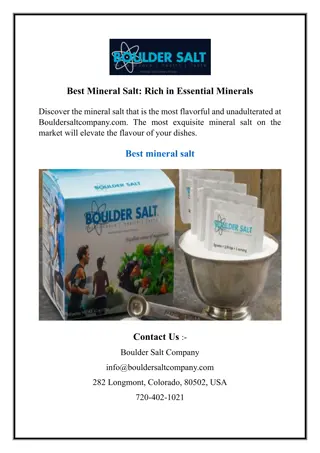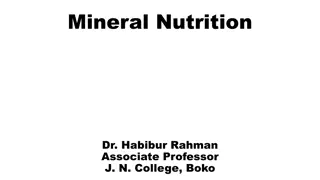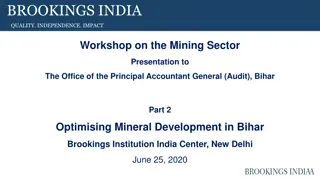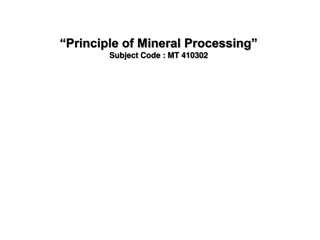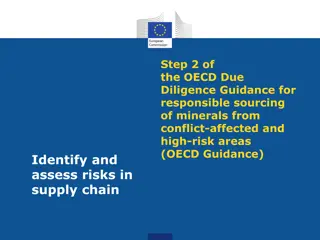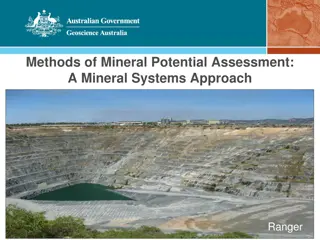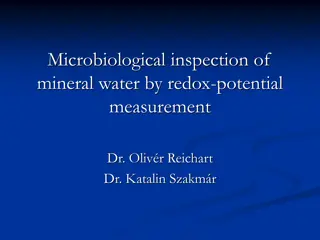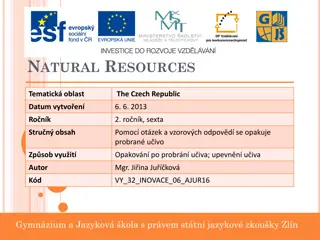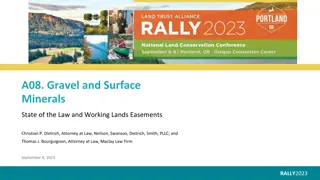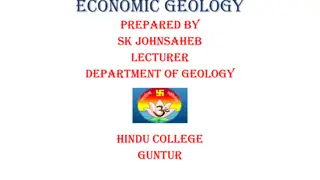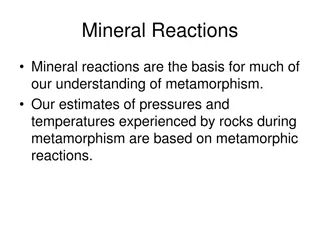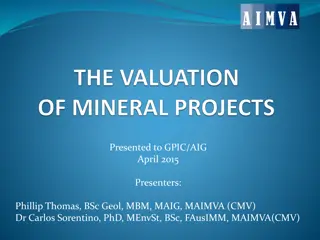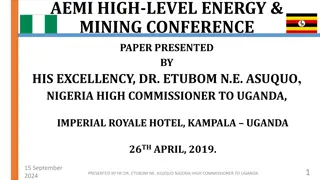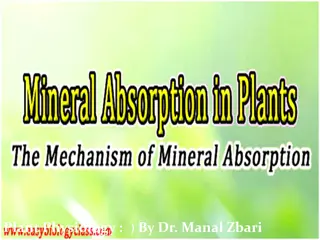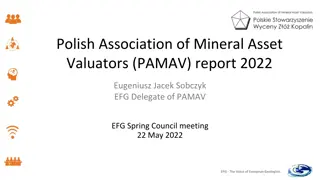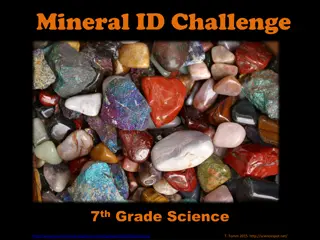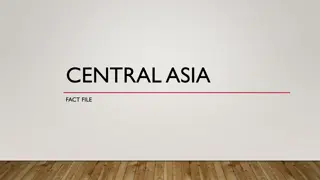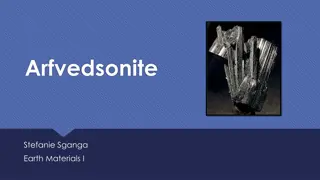
Mineral Resources: Categories, Uses, and Conservation
Explore the world of mineral resources, from definitions to categories like metallic and non-metallic minerals, their uses, examples, and the importance of conservation. Discover how these resources are vital for socio-economic development.
Download Presentation

Please find below an Image/Link to download the presentation.
The content on the website is provided AS IS for your information and personal use only. It may not be sold, licensed, or shared on other websites without obtaining consent from the author. If you encounter any issues during the download, it is possible that the publisher has removed the file from their server.
You are allowed to download the files provided on this website for personal or commercial use, subject to the condition that they are used lawfully. All files are the property of their respective owners.
The content on the website is provided AS IS for your information and personal use only. It may not be sold, licensed, or shared on other websites without obtaining consent from the author.
E N D
Presentation Transcript
StudyMafia.Org Mineral Resource Submitted To: Submitted By: Studymafia.org Studymafia.org
Table Contents Definition Introduction Categories of Mineral Resource Uses of Mineral Resource Examples of Mineral Resource Conservation of Mineral Resource Conclusion 2
Definition A mineral is a naturally occurring substance, representable by a chemical formula, that is usually solid and inorganic, and has a crystal structure. 3
Introduction Mineral resources are the key material basis for socio-economic development. Statistical results show that more than 95% of energy used by mankind, 80% of industrial raw materials and 70% of raw materials for agricultural production are from mineral resources. A mineral is a pure inorganic substance that occurs naturally in the earth s crust. More than two- thousand minerals have been identified and most of these are inorganic, which are formed by the various combination of elements. 4
Categories of Mineral Resource Mineral resources can be divided into two major categories. Metallic Mineral Resources Non-metallic Mineral Resources There are metals that are hard and conduct electricity and heat with characteristics of lustre or shine. Such metals are called metallic minerals. For example Silver, Chromium, Tin, Nickel, Copper, Iron, Lead, Aluminum, Gold, and Zinc. 6
Categories of Mineral Resource Metallic Minerals Metallic Minerals show a metallic shine in their appearance. The potential source of the metal can be got through mining. Contains metals in their chemical composition. Metallic minerals contain metal in raw form. 7
Categories of Mineral Resource Minerals that contain iron are called ferrous minerals. Example of ferrous minerals is Chromites, Iron ore, and manganese. Minerals that do not contain iron are called non-ferrous minerals. Examples of nonferrous minerals are lead, silver, gold, and copper. 8
Categories of Mineral Resource Nonmetallic Mineral There is a group of chemical elements that when melted do not generate a new product. Such special groups are called Nonmetallic minerals. Example: Dimension stone, halite, sand, gypsum, uranium metal, gravel. Minerals appear with a non-metallic shine or lustre Do not contain extractable metals in their chemical composition 9
Uses of Mineral Resource The use of minerals depends upon their deposits. Some countries are rich in mineral deposits, while others have no deposits. The greatest use of minerals depends on their properties. For instance, Aluminum is light, strong and durable in nature, so it is used for aircraft, shipping, and car industries. 10
Uses of Mineral Resource Minerals are used in almost all industries. Gold, silver, and platinum metal are used in the jewellery industry. Copper is used in the coin industry and for making pipes and wires. Silicon obtained from quartz is used in the computer industry. Mineral elements give fireworks colour. 11
Uses of Mineral Resource Barium produces glossy greens; strontium yields dark reds; copper yields blues; and zinc yields sodium. Mixing elements can make many colours: strontium and sodium create bright orange; titanium, zirconium, and magnesium alloys create silvery white; copper and strontium make lavender blue. 12
Examples of Mineral Resource Minerals are compounds naturally produced on Earth. They have a clear structure and chemical composition. There are more than 3000 known minerals. Some, like gold and diamond, are rare and precious, while others, like quartz, are more ordinary. 13
Examples of Mineral Resource Over 99 per cent of the minerals that make up the surface of the Earth consists of only eight elements. Some of such elements are found as complexes in conjunction with other elements. Minerals are naturally occurring elements or compounds in the Earth s crust. Rocks are minerally shaped mixtures. Much as the building blocks of rocks are elements, the rocks form the rock building blocks. 14
Examples of Mineral Resource The mineral biotite has basal cleavage which means that it has a complete cleavage. The cleavage plane on top of this sample is visible on the smooth, reflective surface. The flat surface at the bottom, in line with the top of the bowl, is similar to the rim and thus reflects the same cleavage axis. 15
Examples of Mineral Resource Minerals are composed of atoms as are all compounds. There are just only a hundred components around us, and they are the fundamental building blocks in everything of us. They can be found in their pure form, or chemically combined with other compound- making elements. A compound is composed of two or more chemically united elements. 16
Conservation of Mineral Resource The total volume of consumable mineral resources is just 1% of all the minerals present in the earth s crust. However, the consumption rate is so high that these mineral resources which are non- renewable will get exhausted very soon. Any minerals usually occur as well- developed crystals and are treated in their crystal types 17
Conservation of Mineral Resource Here are some measures to conserve minerals: Use of minerals in a planned and sustainable manner. Recycling of metals Use of alternative renewable substitutes. Technology should be improved to use the low-grade ores profitably. 18
Conservation of Mineral Resource A detailed nomenclature has emerged to classify crystal types and may be familiar with some common names. Different properties aid in the detection of other minerals. For certain minerals, these properties may not be distinguishable enough to aid in their detection. And, they can only be found in some minerals 19
Conclusion A mineral resource is a concentration or occurrence of solid material of economic interest in or on the Earth's crust in such form, grade (or quality), and quantity that there are reasonable prospects for eventual economic extraction. 21
Thanks To StudyMafia.org



